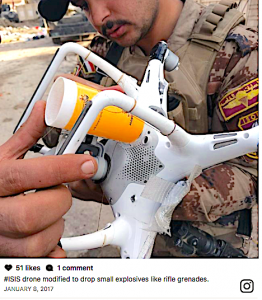 EMERGING TECH
EMERGING TECH
 EMERGING TECH
EMERGING TECH
 EMERGING TECH
EMERGING TECH
President Donald Trump’s new drone technology plans and policies won’t be enough to restore U.S. leadership in the sector, according to a former intelligence official who helped Ronald Reagan amp up critical American missile defense technology during the Cold War.
What’s more, the policies won’t help protect American lives and interests from drone-based terrorist attacks, Michael Sekora, former director of Project Socrates, told SiliconANGLE in an interview. The classified Defense Intelligence Agency tech initiative is often credited with transforming Reagan’s stalled “Star Wars” Strategic Defense Initiative vision into a multitiered technology that leapfrogged Soviet missile defense technology in the late 1980s.
Sekora’s commentary arrives in the wake of news this past week that yet another American drone hardware effort is grounded: On Monday, GoPro Inc. became the third major American drone company to quit the drone hardware business. Lily Robotics Inc. and 3D Robotics Inc. shuttered their respective drone hardware plans in 2017, citing hard competition from Chinese drone behemoth, Dà-Jiāng Innovations.
DJI controlled more than 70 percent of all commercial drone sales last year, according to Federal Aviation Administration numbers released in November. Those losses are humbling, Sekora said, when you consider that the U.S. all but created the drone sector and wielded near-monopoly control over it for years after its first public use of military attack drones in Afghanistan following the Sept. 11, 2001, terrorist attacks.
But U.S. monopoly control over drone tech evaporated a long time ago. According to defense experts, some 90 nations now possess drone technology. And a third of those — including U.S. rivals such as China, North Korea and Iran — now also have full-blown weaponized military drones. Worse, terrorist organizations, rebel groups and other nonstate enemies have drones now, too, raising fears about potential drone-based terror attacks.
“Terrorist organizations have an interest in using drones, and we’ve seen that overseas already with some frequency,” FBI Director Christopher Wray told lawmakers at a Senate Homeland Security hearing in September. “And the expectation is it’s coming here, too. Imminently.”
Military technologists and various third parties are working hard on technology to capture and destroy enemy UAVs, he said, but “it’s a challenge.” Big drones are findable via radar and GPS detection, but it’s far more difficult to detect, defend against and destroy small consumer drones that rogue actors such as the Islamic State, Hamas and Hezbollah now freely buy and customize to surveil and attack their enemies. Such drones, whether solo or in swarms, are small, fly too low to be detected by radar and rarely rely on detectable GPS tech.
 The Pentagon has launched a $700 million program to address the menace of drones from the Islamic State and other terrorist groups. It gathers U.S. military resources plus those from big defense contractors and Silicon Valley. But the program is embryonic and still a long way from reality. As a stopgap, the Pentagon has been sending teams of tech experts to Syria, Iraq and Afghanistan to train and otherwise help American troops defend against enemy drones.
The Pentagon has launched a $700 million program to address the menace of drones from the Islamic State and other terrorist groups. It gathers U.S. military resources plus those from big defense contractors and Silicon Valley. But the program is embryonic and still a long way from reality. As a stopgap, the Pentagon has been sending teams of tech experts to Syria, Iraq and Afghanistan to train and otherwise help American troops defend against enemy drones.
“These things are really small and hard to detect, and if they swarm in groups, they can overload our ability to knock them all down,” J.D. Johnson, Raytheon Co.’s head of army programs, said earlier this year. For instance, according to U.S. intelligence reports, IS has been using DJI’s tiny Phantom drone to surveil its enemies or drop explosives on them (right).
U.S. Central Command has been training Army troops on third-party jamming technology such as national lab manager Battelle Memorial Institute’s DroneDefender (below). It’s a “point-and-shoot rifle chassis” that can disrupt a UAV’s radio control signals or GPS system, which stops target drones in midflight and forces them to land.
It’s a good stopgap, but the U.S. is still a long way from having a foolproof drone terrorism defense plan. “I don’t think (these technologies are) ready right now,” former U.S. Army Special Forces commander Michael Waltz told American journalists earlier this year. “We don’t have the technology –- the detection technology and the countermeasure technology -– truly in place yet.”
The threat of drone-based terror attacks is a direct result of America’s lost leadership in the sector, because it no longer calls the shots on drone technology. As a result, said Sekora, it has little influence over who gets to buy and sell it.
New policies are the answer, according to the Trump administration and the FAA, which recently broke out a spate of new drone policies to make it easier for U.S. companies to build, test, license, fly and sell drones here and abroad.
But policies such as the FAA’s Unmanned Aerial Systems Pilot Program, which it unveiled last month with the tagline, “Make aviation great again,” won’t win back American drone dominance nor keep American enemies from droning up, said Sekora.
“These policies won’t do it,” said Sekora, who is now president of the consulting firm Quadrigy, which sells a third generation of Socrates TechSpace tools such as research and automated competitive analysis. “They’re just the same old State Department-type policy statements written by committees of MBAs and private consultancies. There’s nothing strategic about them.”
Sure, deregulation will help line a few pockets, he added, “but in the end, such policies “treat the symptoms, but not the disease.” That “disease,” he said, is the selfsame one Project Socrates identified four decades ago as the main reason for America’s declining economic competitiveness.
Project Socrates was set up in 1983 to identify the reasons behind America’s declining competitiveness against rivals such as Japan and the former Soviet Union. The main culprit? A gradual American business shift from technology-based strategic planning to what Sekora calls “financial-based strategic planning.”
“When we applied that and other Socrates principles to “Star Wars,” American missile technology suddenly was able to rapidly surpass Soviet technologies, said Sekora.

Battelle’s DroneDefender (Photo: Battelle)
A technology-based strategy plan required then, as it does now, a fundamental business strategy paradigm shift: a concerted effort among government, industry and academia to form the alliances needed to gain competitive advantage. Such a technology-first focus calls for American companies and government to focus mainly on acquiring the best technologies, regardless of who builds them. Costs, profits and other financial considerations take a backseat in such an arrangement.
That’s the way American industry worked for generations, of course. But after World War II, when a victorious America emerged as the world’s premier leader in countless industries, companies stopped worrying about gaining competitive advantage through the best technologies and forging the industry, academic and government alliances needed to get there. Instead, they began making business decisions based on what would save or make the most money in the short term.
Gradually, quarterly results, budgets and profits became the filters through which all decisions were made. That’s sufficient when there’s no competition to speak of, he said, but it’s a short-sighted approach in today’s crowded technology markets, many of which are now dominated by China.
”When we forced a switch back to a ‘best technology’ focus, ‘Star Wars’ tech leapt forward to surpass Soviet missile defenses,” Sekora said.
Returning to that tech-first focus may be the only way America can regain control and guidance of the exploding commercial and military drone sectors, he said. Only when the U.S. can call the shots in terms of drone tech and who’s allowed to buy and sell it can it do anything about the drone terror threat.
Despite its apparent success, Pres. George H.W. Bush ended the Project Socrates initiative in 1991. Reports at the time said Bush was violently opposed to any government policy or organization that interfered with American businesses. So Sekora and other members of the team launched Quadrigy in Austin to continue work on Socrates and the automated tools it developed to help industries, governments and academia develop deep, detailed tech-based strategies.
But in 2002, Socrates and Sekora were back on Capitol Hill. Adm. Craig Dorman (ret.), then chief scientist of the Navy, tapped Sekora to bring Socrates-style tech-based planning to the military, beginning with the booming drone sector. Could Socrates help retain American control of the space?

Michael Sekora
“We set out to identify the nature of drone technologies and strategies that countries all over the world were already executing,” he said. The resulting research “made clear to us that almost all countries would soon have UAVs, minimizing any competitive advantage the U.S. enjoyed at the time,” said Sekora. And when anyone can buy or sell drones, he realized, terrorists and other nonstate actors would be able to leverage their power, which would be a huge national security threat.
“All of this would soon have the effect of immediately negating the strength of our drone-centered military strategies at home and abroad,” Sekora said. “So we came up with a technology strategy for drone industry companies, academics and government, which would enable the U.S. to maintain both control and a competitive advantage in UAVs for many years well past 2013,” he said. The plan relied on the creation of industrywide alliances among academia, government and drone suppliers. Specifically, it suggested an alliance between the DoD and Ford Motor Co., which was working on drone sensor development.
Dorman, Sekora and the Quadrigy team pitched that technology-first drone strategy proposal to the Defense Department, but the reception was cool.
“Like a lot of people at the time, the Defense Secretary was certain that the U.S. would remain the leading developer, manufacturer and arbiter of drone tech because, he said, the barriers to entry were too high for other nations,” he said. Moreover, the department resisted what it called “an unlikely and unprecedented alliance between Ford, the government and industry,” saying that tactic “was way too aggressive.”
After months of debate and endless argument with the DOD, Sekora and Dorman finally gave up. Fast-forward 16 years, and their predictions have come true: Today’s drone sector is dominated by China, and terrorist access to drones resulting from the drone tech diaspora now constitutes a major national security threat.
Time is running out for the U.S. to regain leadership. The election of an outsider like Trump initially gave him hope that the U.S. would once again use Socrates findings and tools to regain lost ground, but Sekora said Trump’s hiring strategy is a bad sign: “Almost without exception, he only appoints people from the world of finance.”
Public perception is a problem, too. Americans “can’t understand that a couple of smart college grads with the right degrees and backing will never be able to outcompete China,” he said. “China is executing a technology-first strategy that enables Chinese industry, academia and government to work as a coherent team to systematically, offensively and defensively outmaneuver all the fragmented players in America.”
And “anyone who believes that China’s big gains are due to cheap manufacturing and mere currency manipulation,” he added, “is terribly mistaken. China’s rapid rise worldwide is 100 percent due to technology-based planning,” he said. “If you can’t see that, you’re not paying attention.”
Gina Smith, Ph.D., is an award-winning tech journalist and New York Times bestselling author of Steve Wozniak’s biography, “iWOZ: How I Invented the Personal Computer and Had Fun Doing It” (2006/2014, W.W. Norton) and “The Genomics Age: Why DNA Technology Changes Everything” (2005/2011, Amacom). Follow her on Twitter @ginasmith888.
THANK YOU